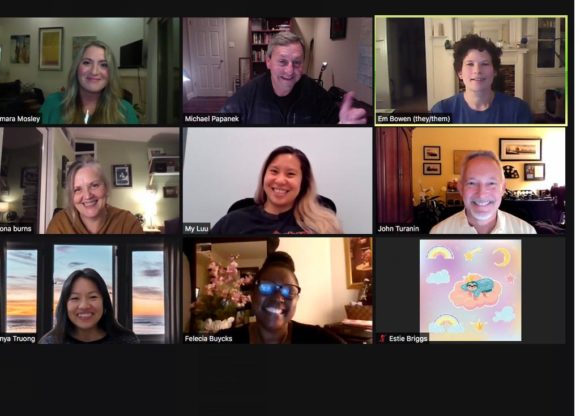The business world is awash in technologies and tools that promise to enable us to work smarter, faster, more productively, and with more people — whether they’re colleagues across the company or around the world. Many new technologies are pegged as collaboration solutions or communications tools — like video and web conferencing, instant messaging, file sharing software, and others. Others are in a class of newer marvels that are broadly referred to as social networking applications — including wikis, forums, virtual team rooms, blogs, and more.
With all these new technologies at the ready, all we need to do is get on line and collaboration just happens, right? Not exactly — in fact, not by a long shot for many teams and work groups that struggle with productivity, effectiveness, or plain old getting things done.
A vital question is at the core of this issue: Are you using technology — or is it using you?
Consider this: A high-tech network solutions company and leading innovator of collaboration technologies recently sought training in how to run successful virtual meetings. An interesting paradox, no doubt, but do they know something we don’t?
It turns out, the answer is that the company understood to make their own excellent collaboration technology pay off, they must remove the human hurdles to collaborating effectively. That’s right: Regardless of the promise of new technologies, the key success factor for collaboration is still how people think, make decisions and resolve conflicts. So, while technology itself gets better and smarter, our human ‘operating system” needs an “upgrade”.
Collaboration: What It Takes
In the rush to adopt the latest technology platform, interfaces, and operating systems, many companies often overlook an important distinction: Technology doesn’t collaborate, people do. And what people need for effective collaboration — the essential ingredients for working together successfully in strong teams — has not changed over the years. Those ingredients include getting buy-in, reaching agreement, navigating conflict, achieving alignment, telling the truth to each other.
Technology has made some of those challenges easier, but others have become harder — and more daunting — with technological advances.
And here’s why: New technologies exaggerate the failures of not working together effectively. It’s one thing if we fail to work together when we’re all in the same room. It’s a whole different kettle of fish if we fail when attempting to work together using Slack, email or other virtual systems.
Obstacles to collaboration
The obstacles to face-to-face collaboration are many and varied. What’s more, they get worse when you take them into virtual space. Most of the obstacles are recognizable — including:
• Organizational hurdles: such as silo-ed departments, complex and unclear roles, and cultural norms with varying rates of dysfunction
• Failure to focus: on just one decision at a time and therefore failing to reach lasting agreements on anything
• Confusing what and how: Focusing only on the “what” (the content) of an interaction vs. understanding the impact of process (the “how”) on collaboration.
• Power dynamics: these thwart full team participation and restrict open communication.
• Wrong assumptions: Not checking assumptions and forming inaccurate conclusions
• Hidden agendas: unseen agendas and conflicts with no method for resolution
• “I Can Do It Myself” attitudes
A recent study on international collaboration from Frost and Sullivan, sponsored by two of the largest technology providers in the world — Verizon and Microsoft — found that a “culture of collaboration” was the differentiator between effective and ineffective companies, and was more correlated to success than the specific technologies in use at the organization.
When people are collaborating globally, cultural issues can be an impediment to effective collaboration. It becomes even more of a necessity to listen, to check assumptions, and be aware of such concepts as “saving face” and mutual respect as reflected in different cultural settings.
The Collaborative Team Profile
Five key attributes are foundational to the success of any collaborative team. A team that is missing one or more of these attributes is at risk for failure.
Briefly, they are:
1. Shared and Meaningful Purpose: The team’s task or reason for existing that is shared by all team members and, in some way, motivates and inspires each.
2. Specific and Challenging Goals: The measurable results the team agrees to produce that will satisfy an important organizational need and demand extraordinary performance by team members.
3. Clear Roles: A shared understanding by team members of how the responsibilities for specific team functions and tasks will be distributed and how the team will make key decisions.
4. Common and Collaborative Approach: Commonly understood plans and methods for accomplishing the team’s goals in ways that facilitate participation, cooperation and mutual support.
5. Complementary Skills: The right combination of knowledge, ability and experience required to perform effectively. In their rush to adopt the latest collaboration technologies to enhance team performance, companies typically overlook an important element in team success: The team’s operating system — what we’ve identified as a set of five key collaborative behaviors required for effective team collaboration.
These team member behaviors enable individuals to act with clarity and integrity, supporting the principle of shared responsibility. What’s more, they form a stable ground upon which teams can work in virtual environments — on the phone, via the web, or by email. While these behaviors are highly effective in face-to-face collaboration, they become even more important in virtual teaming and interacting.
These five behaviors include:
Listen In
Inquiring about what your teammates are saying so that you truly understand their ideas and concerns.
Many team members struggle with the temptation to interrupt colleagues in order to insert their own points of view. Consequently, many teams display a chronic pattern of interruption and evaluation which undermines trust and stalls progress. On collaborative teams, individuals honor each other by listening to understand and validating others’ opinions before advocating for their own ideas. In turn, being heard often enables the speaker to soften his or her own position and search for solutions that work for everyone.
Observable actions include:
• Paying attention until your teammate has finished speaking.
• Checking for comprehension by asking clarifying questions.
• Showing curiosity about your teammates’ views by probing for more information.
• Receiving and validating your teammates’ ideas by responding with summative, reflective and supportive statements.
On-line it means:
• Matching the communication method to the complexity and conflict in the topic or issue. For example, if someone’s email or text message seems “way off” or “antagonistic”; it may be time for a phone call or face to face meeting.
• Leaving time in the agenda for understanding and inquiry.
Speak Out
Advocating for you own point of view while representing the views of others.
Knowing when and how to make your voice heard is a key competence for team members to have. For some, the biggest challenge is to avoid dominating the conversation. For others, it’s taking the risk to voice their opinions and share their points of view. The consequences for the team of either behavior are often the same – stifled creativity and loss of energy and momentum. By stating their views in an honest and timely way, facilitative team members can reduce unnecessary conflict and enhance team productivity.
Observable actions include:
• Offering information at the time it is most useful to the team.
• Saying what’s going on when you realize the group is stuck.
• Putting challenging or difficult information in a context that helps others to hear and understand it.
• Explaining your point of view by sharing underlying assumptions.
On-line it means:
• Reviewing email or other electronic communication from the receiver’s point of view. Might a comment or idea be misunderstood? Are there underlying assumptions you can make explicit, to prevent confusion?
• Considering how the receiver’s cultural environment might impact the reading of your message.
Facilitate Agreement
Helping team members to work through the agreement-building process.
A team often experiences frustration when its members work at cross-purposes. This can lead to the feeling that no agreements are being made and nothing is getting done. This “wheel spinning” and confusion most often occurs because the team has no common understanding about the desired outcomes of their meetings and how they want to proceed. When at least one team member focuses on managing the process and facilitating team member agreements, the whole team can move ahead more easily. By directing the flow of information, team members help to build the understanding and agreements the team needs to take concerted action.
Observable actions include:
• Assessing the situation and making proposals for how to move forward.
• Helping the team stay focused on its desired outcomes and the process for reaching them.
• Finding small agreements and building on them.
• Focusing the team on agreement, not disagreement.
On-line it means:
• Appointing a team member as process facilitator, who has the skills to ensure the process used is effective, clear and followed throughout the meeting. For example, each location in a conference call or video meeting should have a local facilitator who makes sure all ideas are heard and agreements are understood and supported by each team member.
Reconcile Differences
Resolving conflict and working through differences of style or opinion.
Differences of opinion and work style are a natural fact of team life. They can be the source of innovation and creativity as well as breakdowns. Breakdowns that erupt from significant differences in opinion and style often escalate unnecessarily into personal disputes and can be especially challenging in an on-line or other non-face–to-face environment. Resolving these conflicts – instead of withdrawing from them – is one of the most valuable and difficult of all team member behaviors.
Effective team members reconcile differences by focusing on underlying interests (versus surface positions), and by building small agreements into lasting solutions. Only by working through conflict can a team take advantage of its diversity of thought and opinion to create inspired results.
Observable actions include:
• Legitimizing all points of view.
• Identifying the critical issues that need to be addressed.
• Surfacing common interests.
• Highlighting areas of agreement.
On-line it means:
• Assessing in advance how much conflict might occur and selecting a technology that will support a safe environment.
• Having a short but enforced list of “ground rules” or “working agreements” which require respectful inquiry rather than only combative debate.
Exchange Feedback
Strengthening team member relationships by speaking about the impact each others’ behaviors have on individuals or on the team as a whole.
Feedback is an invaluable tool for learning. Yet hearing the phrase, “I’d like to give you some feedback” causes many people to cringe with dread. Effective team members give and receive feedback in the spirit of mutual support and respect. Providing complimentary feedback or requesting someone to change their behavior are normal parts of a team’s daily communication and relationship management. By giving and receiving feedback, team members increase their ability to work together successfully, and expand their collective skill base.
Observable actions include:
• Acknowledging another team member for something he or she does that supports you and/or the team.
• Requesting that a teammate change his or her behavior by describing the behavior, its negative impact, and suggesting an alternative.
• Asking for and listening to feedback without defending your own actions.
On-line it means:
• Leaving time at the end of the meeting to share positive feedback and acknowledgements as well as ways the process could be improved.
• Using a private/secure technology to give any feedback that may be hard for the receiver to hear.
Final thoughts
The late historian and chronicler of technology, Daniel Boorstin, once observed a central paradox about modern technology: It connects people and brings us together, but often at the cost of pushing us apart. No doubt anyone who’s ever been caught in a room full of people working their Blackberries can relate to what Boorstin meant.
In terms of working together effectively, the key question is: Are you using technology in ways that augments other processes and mechanisms for collaborating with colleagues? You might ask if you’re more engaged with the features & functions of a tool or technology — and less so with your colleagues or fellow team members. And that brings us back to a central question posed at the outset: Are you using technology — or is it using you?







